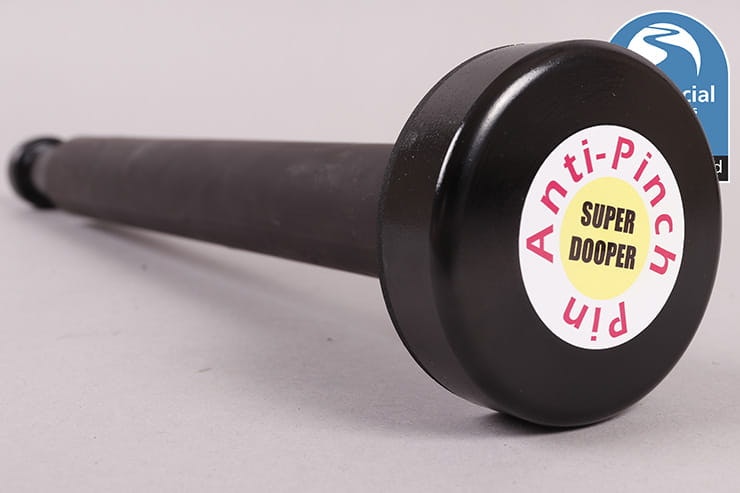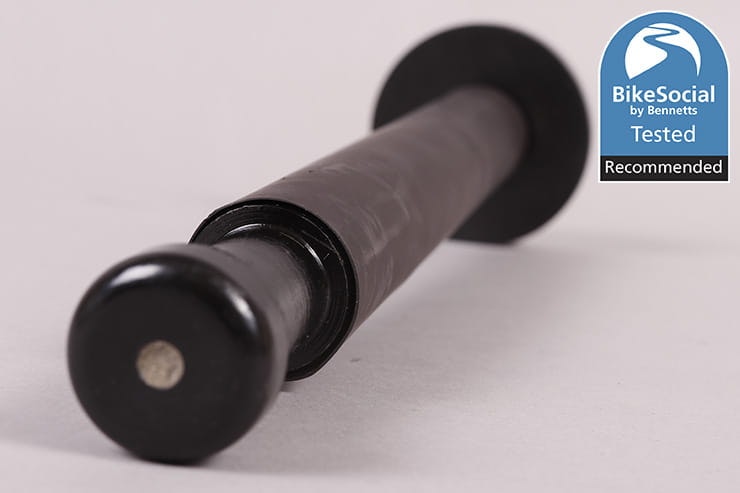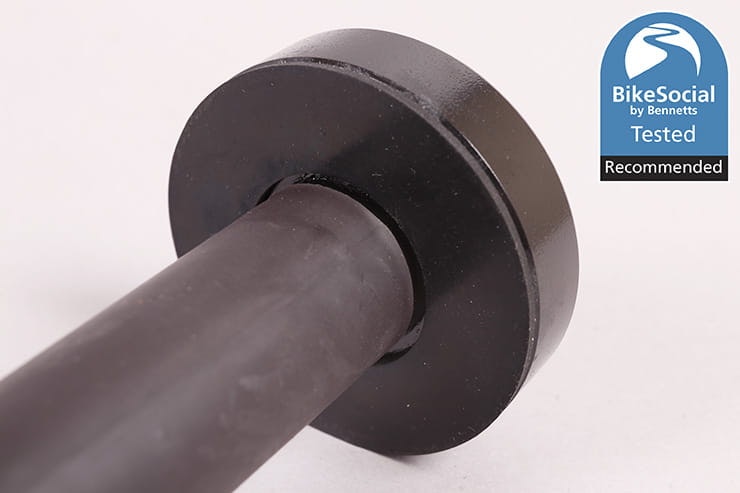Pragmasis Anti-Pinch Pin review | Super Dooper and Super Pins tested
By John Milbank
Consumer Editor of Bennetts BikeSocial
07.12.2022
The Super Dooper Anti Pinch Pins comes with rubber paint protection and a protective cap on the end already installed (not shown here)
Date reviewed: September 2022 | Tested by: John Milbank | RRP: £120 (Super) - £180 (Super Dooper) | securityforbikes.com
Using ANY security has been proven to significantly reduce the chances of your motorcycle being stolen, and the heaviest-duty kit will – according to the data we compiled from 200,000 Bennetts motorcycle insurance customers – make it less likely to be stolen than the average car!
While the internet is full of scare stories and people who seem to try to justify not bothering to lock their bikes, it is true that a determined thief – given enough time and equipment – will be able to defeat anything. Logically, anything that can be made, can be broken, but security is all about making it harder for the criminals.
The Pragmasis Anti-Pinch Pin is designed to pass through the axle, swingarm or frame of your motorcycle, then allowing a chain to tether it to a ground anchor or similar. This review covers the Super Anti-Pinch Pin and the new Super Dooper Anti-Pinch Pin, the latter of which I’m using on a 2019 BMW R1250GS…
Adds a significant layer of security to your bike
Very well made in the UK
Easy to use and protective additions keep paint safe
None
In use
The original Anti Pinch Pin, launched back in 2007 and unique to Pragmasis, was designed to work with a 16mm or 19mm chain; once passed through an opening in the bike’s frame, swingarm or open rear axle (like on many Ducatis and shaft-driven BMWs), it effectively extends a chain’s reach all the way through the motorcycle, with a Squire SS65CS padlock keeping it all in place.
I’ve generally secured my bike at home with a chain through the rear wheel, but the weak point of this method is that, potentially, a thief could remove the wheel and take the rest of the bike. Now this is unlikely, as it adds more time to their attack and if the bike’s tucked well into a corner it could be very difficult indeed. But it is a consideration, and using an Anti Pinch Pin means it’s impossible.
Whether this kit will work for you or not depends very much on your bike, as not everything will have a suitable ‘hole’ through the frame or swingarm to take the pin. Having said that, most machines will have an area that this will pass through, so if you’re looking for the absolutely most secure way of chaining your bike down, this is it. The pins are available in different lengths though, and if in doubt, you can always contact Pragmasis for advice.
The Super Anti-Pinch Pin works with the Squire SS65CS padlock
Due to the fact that most of the pin is covered by the bike, chain and lock, the original Anti-Pinch Pin offered excellent resistance to attack. However, Pragmasis is constantly evolving its products in the Tamworth workshop, and developed the £120 Super Anti-Pinch pin, which incorporated design tweaks and a tungsten carbide insert that makes it even more resistant to an angle-grinder attack.
And now the £180 Super Dooper Anti-Pinch Pin has been released, which sees the tungsten carbide insert in an even thicker pin, designed for 22mm chains and the Squire SS80CS padlock or the ASSA Abloy PL362.
The Super Dooper Anti-Pinch Pin is designed for the Squire SS80CS or a separate model is available for the ASSA Abloy PL362
My BMW R1250GS has spoked wheels, which I could get my 19mm chain through but it was a fiddle and I had to take care not to scratch the anodising as I jiggled it in. The risk was also that a thief might remove the wheel, which is relatively easy on this bike. By using a 260mm Super Dooper Anti-Pinch Pin, I was able to use a short length of 22mm chain secured to a Pragmasis Torc Mega ground anchor.
Fitting is incredibly simple – pass the pin through the bike’s rear axle, slide on both ends of the chain, then secure the padlock in place. There’s very little to scratch on the bike locking it this way, but the Super Anti-Pinch pin has the option to add heat-shrink tubing on the main shaft, a rubber washer covering all of the back, and a protective end-cap for £9. This protection is fitted as standard to the Super Dooper pin. It’s quick and easy to fit the pin (meaning you’re more likely to do it), and there’s no risk to the bike. The pin itself also has a tough eletrophoretically-coated finish that keeps it looking good, and it keeps it free from corrosion.
The Anti Pinch Pins are ordered by ‘usable length’, meaning the shaft length between the padlock and the head. Choose one that’s as short as possible while still fitting through your bike with space for the chain, but if you’re in any doubt, the team at Pragmasis will be more than happy to help you.
The Super Anti-Pinch Pin has a shaft diameter of 24mm, while the Super Dooper Anti-Pinch Pin is 30mm (the heat-shrink adds 1mm). It’s worth noting that, while I used a length of Pragmasis 22mm chain, I found the Oxford Beast and Milenco 22mm chain were also both compatible. Pragmasis offers its 22mm chain in ‘bare ended’ lengths as short as 1 meter, which keeps it less accessible to attack.
While I’ve got both links of chain at the opposite end of the pin’s cap on my GS – thanks to it being impossible to pass all the way through the axle – another way of fitting this is to have the chain at either end. For instance, you might have a bike with a gap between the engine and frame, or perhaps a brace in the swingarm. While getting a chain all the way through here could be impossible (or risk damage to the bike), the pin can pass through to create an extension. That way, it doesn’t matter whether the pin could be slid all the way through becasue the chain is now on both sides of the bike, the pin joining the two ends: with the chain looped through a ground anchor, the bike couldn’t be more secure. This also gives you the option of using the pin through spoked wheels if you want. The picture at the bottom of this page shows how it can be used.
Pragmasis Super Anti-Pinch Pin. Note that destruction testing requires several samples, so I used pins that had only been sprayed with black paint. The sale items have a much tougher electrophoretically-coated finish.
Pragmasis Super Anti-Pinch Pin: resistance to attack
There’s very little of the Pragmasis Super Anti-Pinch Pin exposed once it’s been passed through the bike, and the chain and lock have been attached, but assuming there is access, the only way to attack it is with an angle-grinder.
Even the largest 42” bolt croppers will not have any impact on the pin, while a sledge-hammer or lump-hammer attack simply dents it. I attacked the pin on an anvil, which put it under much more stress than it would encounter if being whacked while fitted to a bike, but it showed no significant signs of damage.
I used my reference mains-powered grinder with 1.0mm cutting-discs, and found it slower to cut than a 19 chain (the largest this will accept). The tungsten carbide insert makes it very hard to get through, and I had to rotate the pin several times before I could get through it. It also caused the grinder to buck several times, which wasn’t a big problem in my controlled conditions with plenty of space, but would be much harder when trying to access it out of reach.
Bolt cropper attack: GOOD
Sledge hammer attack: GOOD
Angle grinder attack: OUTSTANDING
To see how this compares with the other locks we’ve tested, check out our best motorcycle locks for home and away.
Pragmasis Super Dooper Anti-Pinch Pin. Note that destruction testing requires several samples, so we used pins that had only been sprayed with black paint. The sale items have a much tougher electrophoretically-coated finish.
Pragmasis Super Dooper Anti-Pinch Pin: resistance to attack
As with the Super Anti-Pinch Pin, the even thicker Super-Dooper Anti-Pinch Pin took longer to cut with an angle-grinder than any 22mm chain thanks to its 30mm diameter and the tungsten carbide insert. Of course, a chain needs cutting twice, but even with that total of 44mm to slice, the insert does its job very well.
Add to this the fact that, as you can see from the picture below of this pin fitted to the R1250GS, there’s no way of getting a grinder to the pin where it would matter, so the chain remains the only really viable point of attack (testing of the anchor proved that this, too, is more resistant than the chain).
By eliminating the option to remove the rear wheel, or by securing through some other part of the bike, this truly does create a superb security set-up.
Bolt cropper attack: GOOD
Sledge hammer attack: GOOD
Angle grinder attack: OUTSTANDING
To see how this compares with the other locks we’ve tested, check out our best motorcycle locks for home and away.
I’m using the Squire SS80CS padlock (£149.95 from Pragmasis) that I’ve had for years, but the Super Dooper Anti-Pinch Pin will also fit the ASSA Abloy PL362, which is renowned for its resistance to picking (though lock picking is practically unheard of in motorcycle theft).
Pragmasis Anti-Pinch Pin review: Verdict
Top quality security must be considered an investment; buy it once and you’ll likely never have to spend that cash again. There’s no denying that, while Pragmasis kit is some of the best value out there, the complete package of a Super Dooper Anti-Pinch pin at £180, and a 1m length of 22mm chain at £129.95 (you’ll need longer to secure a bike through the frame), plus £149.95 for the Squire padlock and £69.95 for the Torc Mega Ground Anchor is a significant expense at a total of £529.85, but it’s far less than a new exhaust system for instance, and it should last a lifetime while keeping your motorcycle as secure as it possibly can be (and BikeSocial members can save 10% with Pragmasis). Of course, you might already have the lock, chain or ground anchor, and are looking to upgrade your security. Also note that, while Pragmasis doesn’t supply the ASSA Abloy PL362, the lock is available from some sellers for as little as around £90, though I found the Squire a fraction easier to fit, and appreciated its intimidating bulk.
Yes, anything can be defeated, but the Pragmasis Anti-Pinch Pin makes the formidable 22mm chain the only really viable point of attack when attempting to steal a bike. Lock it with the chain out of reach against a wall and any thief really will struggle to beat it. And it’s really quick and easy to use… thoroughly recommended.
To see the other chains and locks tested by Bennetts BikeSocial, click here and be sure to regularly check for the discounts available through BikeSocial membership.
Find out how and why we did this test
Consumer editor John Milbank explains how you can get the best out of your chain and lock, and how this test was done


